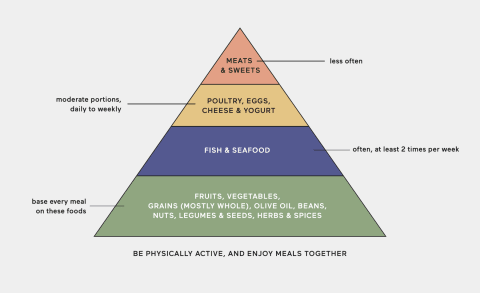Advertisement
What Exactly Is The Mediterranean Diet Food Pyramid?

You probably remember learning about the food pyramid as a kid—all the different nutrition categories, layered in order of priority. This pyramid started with the most important group at the bottom, moving to the least crucial at the top.
While the food pyramid you learned about in school probably isn't super helpful anymore (if you recall, that bottom category was bread), there is another guide that might be worth checking out. The Mediterranean diet—which was named the top diet for overall health in 2020 and is known for its many science-backed benefits—actually has it's own food pyramid.
To get a better understanding of what foods makes up a healthy Mediterranean diet, we dug into the history of its food pyramid and asked registered dietitian Molly Knudsen, M.S., RDN, to weigh in.
What is the Mediterranean diet food pyramid?
"The Mediterranean diet pyramid depicts the traditional dietary and lifestyle elements of countries that border the Mediterranean Sea and can be interpreted as a guideline for following a Mediterranean diet," Knudsen explains.
It was developed in 1993 by Oldways, a food and nutrition nonprofit, with the help of the Harvard School of Public Health and the World Health Organization.
The base of the pyramid represents foods that you should eat every day and incorporate into every meal. They include: fruits, veggies, whole grains, olive oil, legumes, nuts and seeds, and olive oil.
The next tier represents foods that you ideally have at least two times per week, including fish and seafood.
Following that are foods to consume in moderation. They include poultry, eggs, cheese, yogurt, and, in some cases, red wine.
Finally, the smallest portion of the Mediterranean diet (usually for special occasions) includes red meat, saturated fats, and some sweets.

The Mediterranean diet pyramid also incorporates physical activity and the concept of enjoying meals with others as necessary components to a healthy lifestyle. Including these aspects is valuable, Knudsen explains, since good diets don’t compensate for lack of physical activity, and vice versa. Additionally, "food and sharing meals with others are some of the oldest ways to connect and build relationships with friends and family," she says. "It also often allows for more mindful, and even slower eating than eating alone."
How does it differ from the USDA food pyramid?
The Mediterranean Diet pyramid was released just one year after the US Department of Agriculture (USDA) released their own dietary pyramid. Here's how that one was broken down:
- First tier: 6 to 11 servings carbohydrates (bread, pasta, rice, and cereal)
- Second tier: 3 to 5 servings vegetables; 2 to 4 servings fruit
- Third tier: 2 to 3 servings dairy (milk, yogurt, and cheese); 2 to 3 servings of protein (meat, poultry, fish, beans, eggs, nuts)
- Top: fats, oils, and sweets, in moderation
Separating the USDA food pyramid by category and recommended daily intake makes it less flexible than the Mediterranean diet pyramid, and gives a limited view on the nutritional contribution of some foods. For example, legumes offer both carbohydrates and protein, and veggies provide a healthy dose of carbs and fiber.
The Mediterranean diet pyramid recognizes that foods categorized as protein in the American diet—fish and seafood, poultry and dairy, and meats—are very different in terms of nutritional value and how often they should play into meals, Knudsen says.
Similarly, lumping together all fats in the USDA pyramid doesn't distinguish between healthy fats (like nuts, seeds, and oils), from unhealthy saturated and trans fats. "It still communicates that all fats are equal and therefore should be limited," Knudsen explains.
Is the Mediterranean diet pyramid still a good model to follow?
The USDA pyramid was considered a healthy model to follow from 1992 to 2005, but the Mediterranean pyramid is still a good example to reference today.
"The Mediterranean Diet Pyramid is flexible enough to be tailored to a variety of taste and dietary preferences, including vegetarian, vegan, gluten free, etc.," Knudsen says.
"Although this pyramid was created back in the '90s, it still represents the current practices and beliefs of what constitutes a traditional Mediterranean diet," she says. Rather than focusing on what not to eat, the Mediterranean diet focuses on healthy patterns of eating and incorporates nutrient-dense, whole foods.
Bottom line
Along with being non-restrictive and easy to follow, the Mediterranean diet has shown to help promote heart health1, manage weight and metabolic diseases2, and even delay neurodegenerative disorders3, like Alzheimer's disease. While the Mediterranean diet pyramid was created in the 1990s, it still aligns with the diet's current healthy eating principles.
Watch Next
Enjoy some of our favorite clips from classes
Enjoy some of our favorite clips from classes
What Is Meditation?
Mindfulness/Spirituality | Light Watkins
Box Breathing
Mindfulness/Spirituality | Gwen Dittmar
What Breathwork Can Address
Mindfulness/Spirituality | Gwen Dittmar
The 8 Limbs of Yoga - What is Asana?
Yoga | Caley Alyssa
Two Standing Postures to Open Up Tight Hips
Yoga | Caley Alyssa
How Plants Can Optimize Athletic Performance
Nutrition | Rich Roll
What to Eat Before a Workout
Nutrition | Rich Roll
How Ayurveda Helps Us Navigate Modern Life
Nutrition | Sahara Rose
Messages About Love & Relationships
Love & Relationships | Esther Perel
Love Languages
Love & Relationships | Esther Perel
What Is Meditation?
Box Breathing
What Breathwork Can Address
The 8 Limbs of Yoga - What is Asana?
Two Standing Postures to Open Up Tight Hips
How Plants Can Optimize Athletic Performance
What to Eat Before a Workout
How Ayurveda Helps Us Navigate Modern Life
Messages About Love & Relationships
Love Languages
Advertisement

These Peanut Butter Cup Protein Bites Make The Perfect On-The-Go Snack
Molly Knudsen, M.S., RDN










